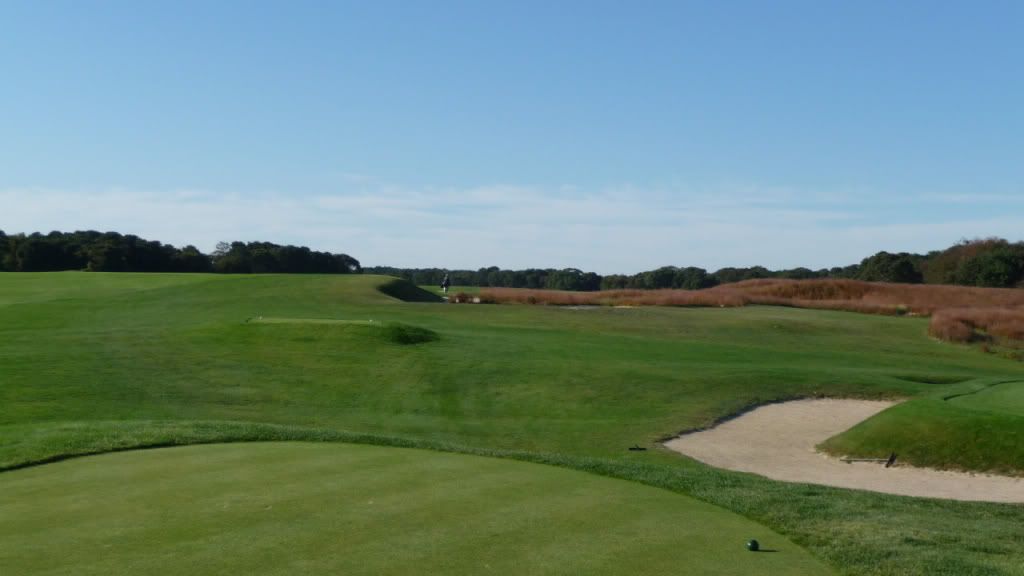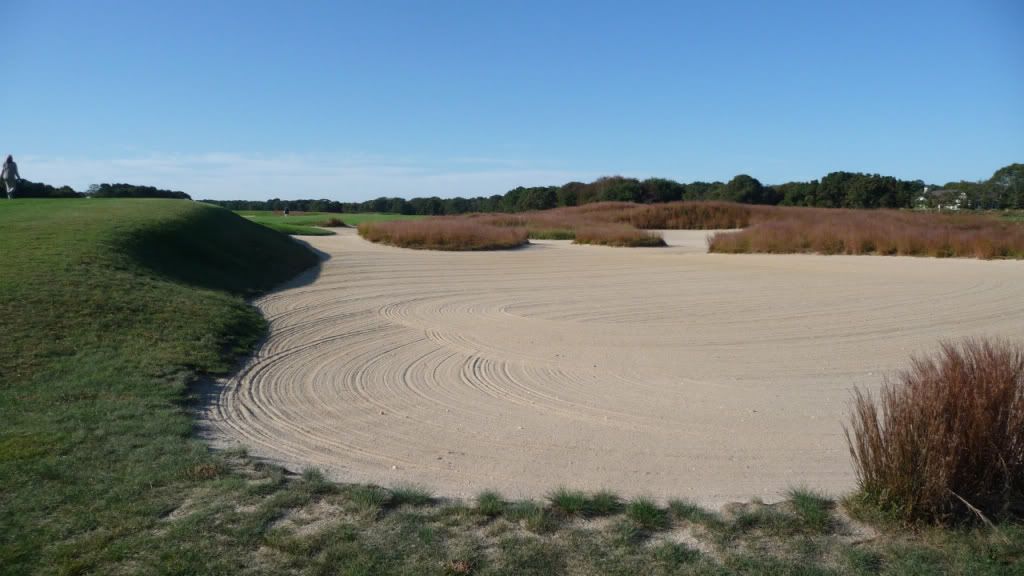As you leave the back of the 6th green, either euphoric, content or disappointed in your perfomance on the short "short" hole, you head toward the 7th tee which sits between the 6th and 12th greens.
Upon reaching the 7th tee, one usually glances over at the 12th green, noticing the hole location, especially as it relates to the mound running through the back third of the green. The hole location, relative to the mound, will later dictate or heavily influence play on that hole.
Now, you turn and look down the playing corridor and are struck by a disturbing question.
"Where in the hell do I aim ?"
Suddenly, you feel disoriented.
There's nothing out their to guide you, no defined DZ, just undulations of grass, mounds and trees on the horizon, stretching from the far left, which you realize is the playing corridor for # 12, to the far right, which looks unappealing, due to the long heavy rough.


Sure, you've looked at the score card, and were encouraged by the mere 478 yards from the back tee, but, where is the DZ, where do you aim.
For there's nothing to provide one with any clear definition regarding the proper playing corridor and/or fairway.
Maybe you bought the yardage map in the proshop, clearly depicting an aerial map of the hole.
Still, uncertainty and doubt overwhelm the senses, and, if you've bought the map, you see all of the randome pot bunkers that seem to lie everywhere outside of the fairway cut. this is an intimidating tee shot.
The tee shot on # 7 is unique in that the 7th and 12th share extended fairways.
Fortunately, you've taken a caddy, so he stands, either on the first ridge, or sedcond ridge, and beckons you to hit it in his direction.
Still, it's an uncomfortable shot into the unknown.
Unfortunately, the distance problem has diminished the PHYSICAL challenge off the tee, for one only needs to carry about 250 or a little more to clear ALL of the right side bunkering complex, a complex intended to represent the hotel and railroad shed at TOC.
In addition, the distance problem allows the longer golfer to avoid a critical intended DZ, "The BOWL" in the middle of the fairway that leaves the golfer with a blind second shot. Here's a photo of THE BOWL, the golfer is toward the upslope on the greenside edge of the Bowl

Having said that, to a degree, Mother Nature has come to the rescue in that a prevailing wind is directly in your face or coming in your face slightly from the left. And, often it's a heavy breeze, laden with moisture off the sea.
Based on the yardage, you were thinking "birdie" but, with no definition and a little wind in your face, you take aim at the caddy and swing away.
Should hour ball sail right, it's eiither in tall rough or the bunker complex.
Extraction from there is a chore, and the prudent golfer, depending upon their lie, merely seeks to exit with a shot decent enough to allow him to get home in regulation.
Drives hit left face a similar, and perhaps harsher fate, as the configuration of the left side bunker can be more difficult than the large sprawling right side bunkers..
If one has hit a good drive, where the caddy directed them, they're probably in "The Bowl", unless they've hit a really good drive which would bring them up onto the plateau, giving them a good glimpse of the green.
For those in the bowl, they're faced with another blind shot..
Irrespective of your position off the tee, a critical factor now enters the equation.
The location of the hole.
It is absulutely critical to the tactics you will or should employ.
If you can't get home in two, and most can't, the next question is, where do I want to be for my third shot, what line and what distance.
The green is angled, basically from High South to low North,
It falls off steeply to the rear to a huge, deep bunker.
The green is slightly elevated, and starts out very narrow at the low North end, and gradually expands.
While the green is 43 yards front to back, measured on it's angle it's probably closer to 50 yards, tip to tip.
Fronting the green is the famous Road Hole bunker. It is deep, and seems to have an affinity for attracting golf balls.
Getting to a hole location directly behind the bunker is a significant challenge.
Flanking the entire right side of the fairway starting at about 100 yards from the center of the green is a set of deep bunkers.
An ideal third shot approach to this angled green would seem to be right next to those bunkers, except for that huge damn tree, branching out so ominously.
To the left, would seem llike a far more benign and safer route.
However, those taking that route would subsequently face a daunting third shot approach, as they would be faced with a dreaded shot to a narrow, firm, slightly elevated green, with the fear and almost certainty of going long, down, into that deep right side bunker.
So, here you are, after hitting your drive, back in the fairway or rough, contemplating your fate, trying to determine your method of play.
By now, your caddy probably has a more realistic assessment of your game than you do. so, his advice can be invalueable.
And, the location of the hole is THE determining factor.
The caddy tells you to hit your 3-wood or rescue or 4 iron down the right side, so that you'll have the best angle and shot to approach the green to.
But, you're afraid of those bunkes on the right, and the wind, which will push everything further right, so, you err on the side of caution and hit to the center or right center of the fairway.
And now, now, the FUN begins.
It doesn't matter if you're 100 yards or 10 yards from the green, the approach shot can be incredibly intimidating.
My old friend, Joe MacBride, a great golfer, showed me how to hit every club, from putter to driver, from 10 or 100 yards from this green. For him, it was all a matter of feel, how he felt that day. Now Joe had a great short game, and he was intimately familiar with NGLA, so he was very comfortable with almost any choice.
But, I can assure you, the fear factor, for what seems like such an innocent, short, easy shot, is extremely high, due to the consequences if you fail.
Now, it you're out for a casual, doesn't count round, well, so what ?
but, if you're trying to qualify for an event, you know that this simple little shot, can decimate your round.
You can make birdie, par, or far worse. So you'd better think this through properly and you'd better execute properly.
Remember, these greens are FIRM and FAST, so the slightest mishit will cost you dearly.
Shold you go right and wrong, the right side bunker is DEEP. You are well below the putting surface.
Hit the ball short, and you're left with deja vu all over again.
And if the hole is located low North, you can end up playing ping pong, going back and forth as the strokes mount up.
So, let's go back in the fairway, knowing all of the above, because unlike TEPaul, you paid attentiion while reading my posts.
Sometimes the more important issue is where you don't hit it.
You don't want to hit it right, you don't want to hit it into the Road Hole bunker and you don't want to ht it far left.
While most don't think of this, on # 7, being a little long isn't a bad thing.
Georgh Zahringer, a terrific amateur, advised me long ago, to err long when approaching # 7, esecially with your second shot, and even on your third, depending upon hole location.
If the hole is cut front, your best bet is to go for the center of the green.
If the hole is cut center, your best bet is to g for the back of the green.
Knowing this and being comfortable with it are two different things.
\
So, depending upon your lie, flat, uphill, sidehill, bunker right, bunker left, rough right, rough left, the wind and your confidence level, you make an informed choice, hoping to execute the best plan possible, given the state of your game at that moment.,
If you've executed a prudent, as opposed to an ego shot, then, you've optimized your chances of getting a birdie and minimized your chances of taking a big number, but, it's not over yet.
I"ve always liked having a breeze in my face as it provided an extra magin of erro for my L-Wedge, which I could hit with more authority, from 5 to 70 yards., depending upon hole location.
Once on the putting surfacce, the challenge is reasonable. The green, while subtle, doesn't have the slope, tiers or mounds found on oher greens at NGLA.
However, like almost all of the greens at NGLA, the edges do feed ball into bunkers, fairway or rough, so care must still be exercised, especially in the narrow, low North section.
With the hole cut front, low North, I've seen seasoned members, who are good golfers, play short of the green, attempting to two putt from just short of the green, get thier par and head to the next tee. It's not a bad strategy when the hole is cut front, low North, as I've seen golfers take big numbers, from just 20 to 60 yards from the hole.
Hitting into the "Road Hole" bunker will almost always lead to a bogey or worse.
Having to traverse the Road Hole bunker will almost always lead to a bogye or worse.
For such a short hole, 478 yards, it can be a killer.
How to overcome the distance problem.
There's a simple solution and it's NOT changing par on the hole.
I'ts moving the tee back 30-50 yardss, such that the "road Hole" bunker complex is brought back into play as CBM intended it.
Ther'e's a plateau back by the maintaince road, that could be a tee, and a tee could be crafted just beyond the maintainance road, making the hole play as CBM intended it.
That would bring te right side bunkers back into play, the Bowl back into play, and the positioning of the second shot for the longer hitteres back into play.
Lastly, RAN, you have to get the "jumping" fixed, it's taken me hours to type this.
Next